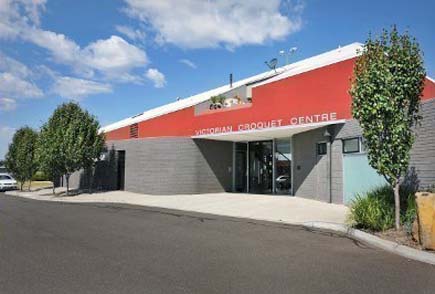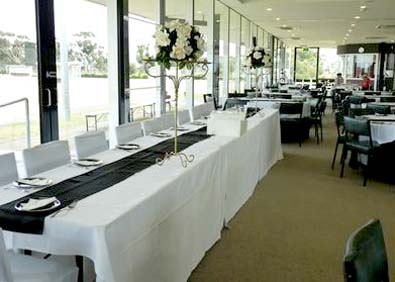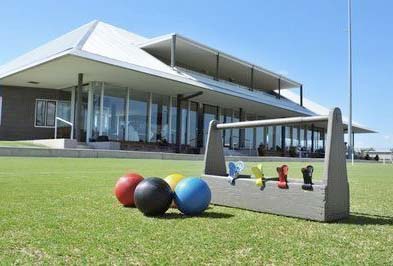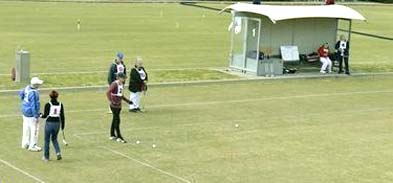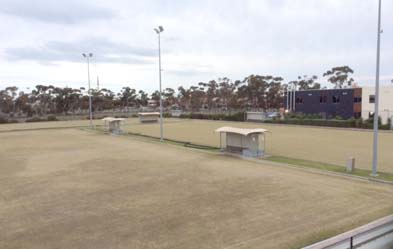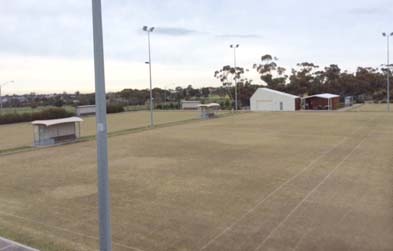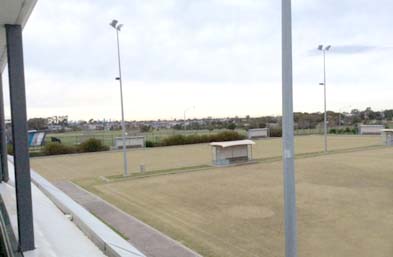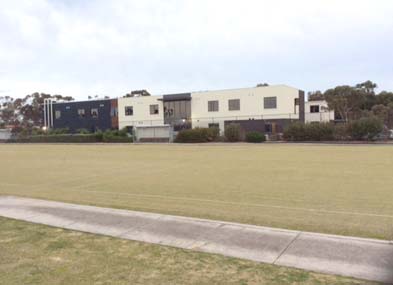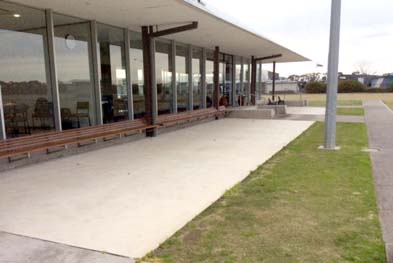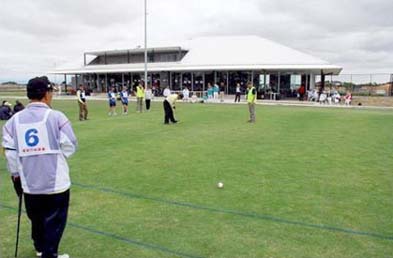

|
Back to |
| The Front Page |
| News & Features |

|
Additions and improvements at the South Florida Center and the Victorian Centre |
||||||||||
|
by Bob Alman with Jim Clement and Tony Hall photos by Johnny Mitchell and others as credited Posted July 16, 2016
|
||||||||||
|
||||||||||
The Croquet Foundation of America, owner of the National Croquet Center, continues to invest in improvements of the buildings and grounds of the 10-acre site as the clubhouse ages and the plantings mature.
The National Croquet Center in West Palm Beach set a new standard in America when it opened in 2003 with 12 lawns and a clubhouse as the USCA national headquarters. Something like the same thing happened a few years later in a western suburb of Melbourne with the establishment of the Victorian Croquet Centre as the focus of the state's activity and a resource for all of Australia. Over time, both facilities have inevitably improved their physical plants as well as their overall operations in many ways. Comparisons are odious, and impossible. So we'll just show you below, beginning with the National Croquet Center, how these centres are turning out as they mature.
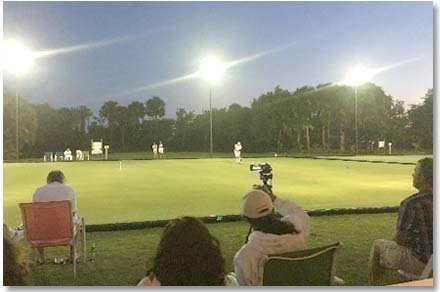
|
Recently installed lights for courts One, Two, and Three were first used at a major event for the finals of the Association Croquet World Championship best-of-five match between a Brit and an American. Stephen Mulliner, the Brit, defeated David Maloof in five games, watched by a couple of hundred spectators from the apron around the clubhouse and the veranda.
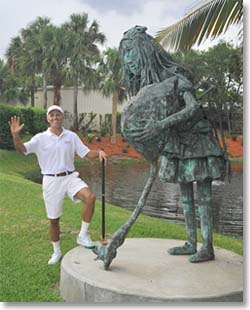
|
It's not that Rick Landry, new and popular club pro, is so tiny. The anonymously donated ALICE is huge and rather fierce, with a flamingo in her grasp preparing to strike onto the lawn the hedgehog standing in for a croquet ball. Her pedestal, in the afternoon shade of the Center's only Arrica palm, provides auxilary seating for both players and spectators beside Court Two. New red-bedded plantings fronting the maintenance shed in the background enhance the irrigation pond. |
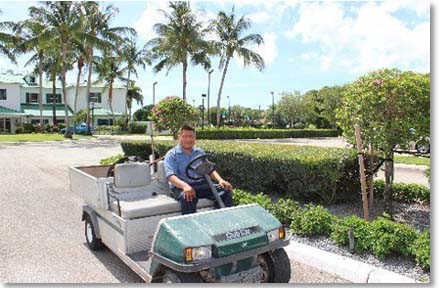
|
Players and event clients are noticing the huge difference made with new gardening and landscape staff. Omero Garcia supervises two other full-time gardeners in maintaining all the landscaping, including the decorative plantings along the entrance drive. The lawns have never been better, players say. Scott Reiser photo.
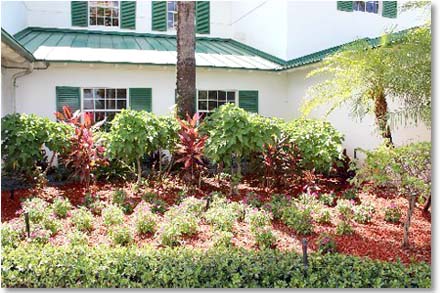
|
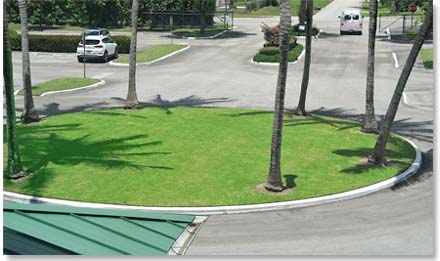
|
The roundabout in front of the clubhouse, shot here from the upstairs utility kitchen that services events upstairs in the ball room for 200 or more, is often used for temporary displays by special events, including weddings. Luxury cars sometimes auctioned off for charity fund-raisers are parked here. So a lush, green, and hardy grass suitable for changing displays now enhances this welcoming space.
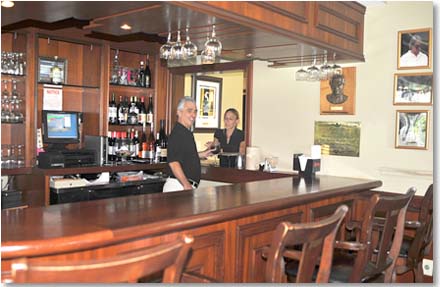
|
Billy Boudreaux works fulltime for resident caterer SandyJames and wants everyone to know that they can get a drink not just when he is there, but any time the cafe is open. Here Lynn Frasier orders wine for a lunch party in the Croquet Grill across the hall.
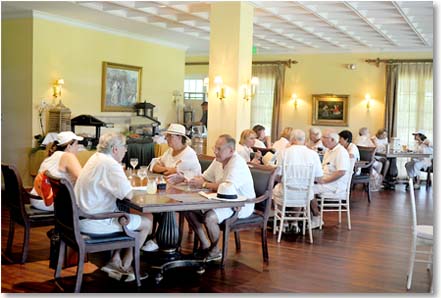
|
The Croquet Grill, open five days a week for lunch in the October-through-May season, has expanded its schedule to include lunch on Thursdays as well as Saturdays throughout the summer. Many special dinners are produced by the members club, and "bar food" is available from the kitchen on Thursday nights, year-round.
| Maria Orengo seems to take a Zen-like satisfaction in doing a job that never ends and is always useful--cleaning the 720 small panes on 40 french doors that encircle the veranda on three sides of the clubhouse. Whenever she finishes the "must do's" in her daily cleaning, she usually polishes the outside panes on at least one of the eight sections of the french doors; and then, the following week, she repeats, with cleaning surfaces already seven days old. Scott Reiser photo. | 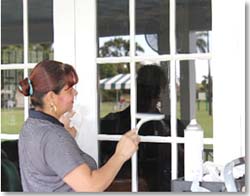
|
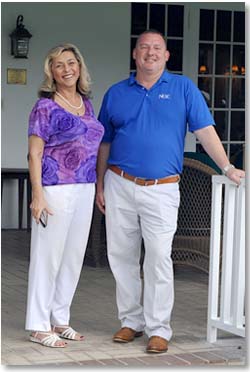
|
Marie Sweetzer and Scott Hanson usually don't stand outside to greet visitors and members--especially in the summer--but they can persuaded to appear for a photo op. Marie is the onsite General Manager and Scott is the House Manager for events of all kinds--private and corporate clients as well as club members. |
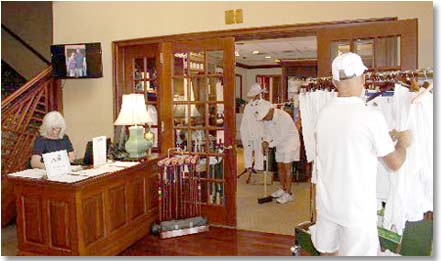
|
Part-time receptionists do triple duty with office work, greeting members and guests when they sign in, and servicing sales from the pro shop--the biggest walk-in croquet pro shop in the world, accessible to tens of thousands of visitors every year. Photo by Scott Reiser.
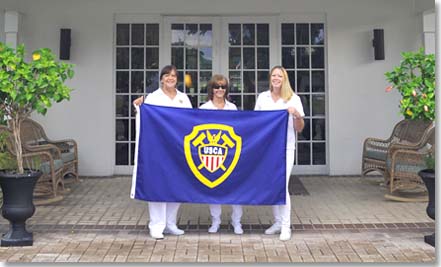
|
| WHO WANTS TO PLAY CROQUET? |
|
Every national organization dedicated to the sport of croquet wants to attract more players by keeping a pulse on trends and personal preferences. The USCA is addressing their survey to everyone who plays in the North America, at any level and on any type of grass--to help them get connected, learn the games, develop their skills, and support the growth of their organizations. Completing this brief and easy-to-answer survey will help ensure that you and your interests are represented.
|
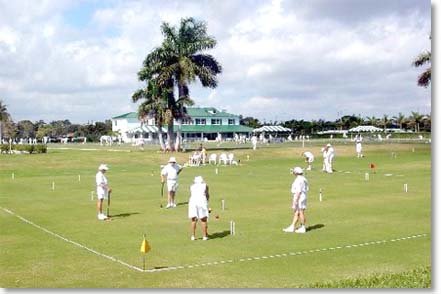
|
No, this is not a recent picture of the huge "dry rentention area" in the back of the Center. It's a "once and future" photo snapped by Bob Alman in 2003, showing how well Bermuda 419 works as a half-court playing surface, cut to one-half inch. In the financial crunch somewhere around 2009, maintenance was stopped and bio-debris was dumped there, making the surface too bumpy for most games. But the irrigation heads are still there, and the area is being gradually restored as a playing surface for many sports and activities, including 9-wicket croquet and reduced-size 6-wicket games. Here it is being used for novice members playing half-court Golf Croquet, which actually works better on this grass than on the super-fast grass of the 12 regular courts, because the slower space moderates the speed of the balls, which beginners find especially difficult. The area above is slated as the first of a three-stage redevelopment planned to begin in the spring of 2017, partially funded by an annual benefit called FLAMINGOS AND SNOWBIRDS organized several years ago as a popular annual by former Assistant General Manager Victorian Albrecht.
|
THE VICTORIAN CENTRE SETTLES INTO ITS NEW HOME In a western suburb of Melbourne, the Centre was opened in 2006 with 12 full-size courts and a state-of-the-art pavilion with office spaces and a resident caretaker's apartment. It's just a few minutes' drive from the Melbourne airport and near the hub of many major highways. As headquarters for all of Victorian's club activities, it's used for interclub and interstate competitions and for many of Australia's national events and World Croquet Federation championships. It's where players in the state gather for special programs on coaching and refereeing.
The Centre doesn't aspire to host croquet clubs, but provides playing space for two small local clubs and makes the facility available for hire for private events, with a large multi-purpose space fronting on the lawns. The building's function area seats 200, with a licensed bar and a commercial kitchen, and overlooks manicured grass courts with night lighting and abundant court-side seating and recently improved shelters for players and spectators. About three years ago the Centre stopped relying on volunteer help and engaged a contractor to look after the courts, which players say are in good shape. The contractor occupies the original shed and the new one provides storage space for both the Victorian Croquet Association and the Australian Croquet Association. The original shed and the new one provide storage space for both the Victorian Croquet Association and the Australian Croquet Association. Globe-trotting Tony Hall reports he has visited the Victorian Centre about every six months for the last few years. He was especially impressed with additional covered area for spectators and outplayers incorporated into an addition to the equipment shed across a broad expanse of lawns from the clubhouse. It has a refrigerator and, he notes, "The roof line is architecturally matched to the original equipment shed."
According to Tony, "The flower gardens around the periphery are blooming and the off-court grassed areas are well tended. Despite cracks in the concrete the whole centre looks good." (Tony refers to a ground condition that also causes occasional buckling of the paving stones on the veranda of the National Croquet Center.) As many as 200 people may dine overlooking the Victorian courts, serviced by a commercial kitchen and a caterer who also does lunches for major events, with good, reasonably-priced fare.
The Victorian Centre uses Australia-produced uses Dawson balls--the best in the world-- and boasts Atkins Quadway hoops for all twelve courts; again, the best.
Australia and Victorian embrace all mallet-and-ball games under the rubrick of Mallet Sports, including Gateball, which is played at many major venues in Australia, including the Victorian Centre.
I asked Jim Clement, recently-retired secretary of the Victorian Croquet Association and Head of Coaching, to send me some recent pictures of the Victorian Centre, and he obliged by sending me the photos snapped from the second floor viewing balcony overlooking the courts. If they look a bit dreary, it's because the pics were snapped in the depths of Victorian's winter under overcast skies, in early July. The courtside shelters around the lawns were improved several years ago to provide better protection from wind and rain.
The maintenance contractor occupies the original shed (white) and the new addition provides extra storage space for both the Victorian Croquet Association and the Australian Croquet Association.
The main building's viewing balcony is a boon to anyone who wants to follow the games on most of the courts. (Such a balcony, originally proposed for the National Croquet Center, was not incorporated into the second-floor plan, so players doing live-streaming shoot from the windows around the ballroom.)
On the Western boundary of the five-acre site, this newly built elder home, along with newly planted trees, may or may not help to reduce the force of winds that sometimes buffet players and spectators.
A new concrete apron in front of the clubhouse is one of many fixes made from cracks created by the shifting ground the Centre is built upon--a characteristic that Victorian shares with the NCC, where the shifting manifests in buckling pavestones on the veranda. Note the sheltered built-in seating.
The Australian National Gateball Championship played at the Victorian Centre in 2008 demonstrates the unique and continuing commitment of the Australian Croquet Association to promote all forms of the sport under the rubric of "Malletsports." With this kind of openness to change and innovation, it's likely that Australia will long continue to boast the largest population of croquet players in the world. Sue Leitenger photo. |
